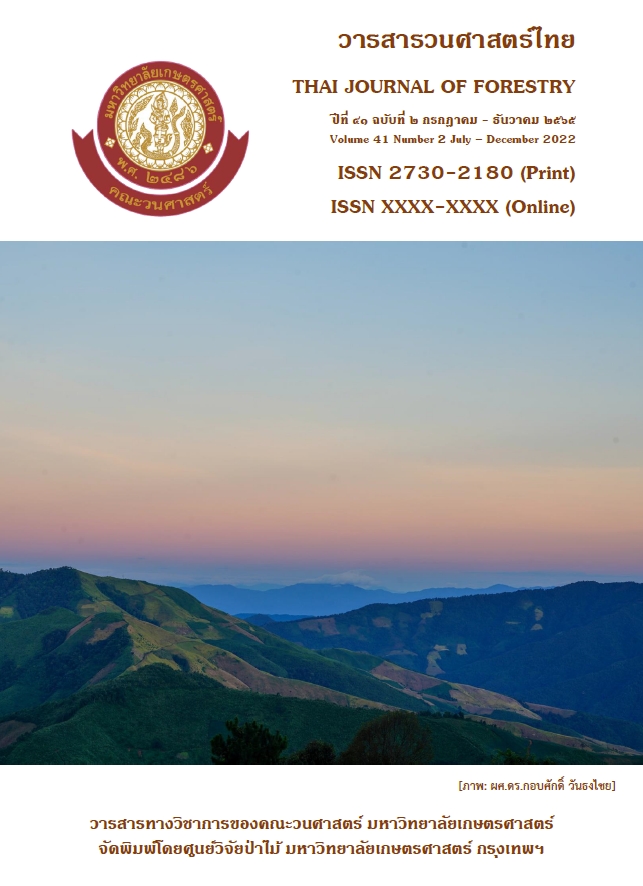ความหลากหลายของชนิดไผ่และการประยุกต์ใช้ระบบสารสนเทศทางภูมิศาสตร์เพื่อจำแนกการกระจายของไผ่ในพื้นที่ป่าชุมชนบ้านปง อำเภอลอง จังหวัดแพร่
Main Article Content
บทคัดย่อ
งานวิจัยนี้มีวัตถุประสงค์เพื่อศึกษาความหลากหลายของชนิดไผ่ในพื้นที่ป่าชุมชนบ้านปง อำเภอลอง จังหวัดแพร่ โดยการวางแปลงด้วยวิธีการสุ่มแบบเจาะจง (purposive sampling) ขนาด 20 เมตร × 20 เมตร จำนวน 24 แปลง พร้อมนับจำนวนกอในแปลงตัวอย่าง โดยในแต่ละกอทำการสุ่มวัดขนาดเส้นผ่านศูนย์กลางเพียงอก จำนวน 3 ลำ/กอ วัดความสูงของแต่ละกอ วิเคราะห์หาความหลากหลายของชนิดไผ่ในพื้นที่ป่าชุมชนบ้านปง พร้อมทั้งจำแนกระดับศักยภาพของพื้นที่ โดยการวิเคราะห์แบบ Natural Breaks (Jenks)
ผลการศึกษาพบว่า มีชนิดไผ่ในพื้นที่ป่าชุมชนบ้านปง 5 ชนิด 4 สกุล 1 วงศ์ มีค่าดัชนีความหลากชนิด เท่ากับ 1.00 ชนิดไผ่ที่มีขนาดลำใหญ่ที่สุดคือ ไผ่ซางนวล (D. membranaceus) มีค่าเฉลี่ยเท่ากับ 22.82 ± 3.22 เซนติเมตร ส่วนชนิดไผ่ไร่ (G. albociliata) มีขนาดลำเล็กที่สุด มีค่าเฉลี่ยเท่ากับ 12.44 ± 2.51 เซนติเมตร เมื่อประเมินความเด่นของชนิดไผ่ในพื้นที่โดยใช้ค่าดัชนีความสำคัญ (IVI) พบว่า ไผ่ซางนวล มีค่าดัชนีความสำคัญสูงที่สุดเท่ากับ 213.80 เปอร์เซ็นต์ และพบว่าการจำแนกระดับศักยภาพของพื้นที่อยู่ในระดับปานกลาง คือ ไผ่ซางนวล ไผ่ข้าวหลาม ไผ่ไร่ และไผ่ไล่ลอ คิดเป็น 32.56, 29.95, 34.32 และ 28.63 เปอร์เซ็นต์ของพื้นที่ทั้งหมด ส่วนไผ่บงดำ (B. tulda) พบศักยภาพต่อการปรากฏอยู่ในระดับน้อย คิดเป็น 31.01 เปอร์เซ็นต์ บงชี้ว่าในการเข้าไปใช้ประโยชน์จากไผ่ต้องพิจารณาถึงการกระจายและปริมาณของไผ่แต่ละชนิด เพื่อการใช้ประโยชน์ที่เหมาะสมและยั่งยืนต่อไป
คำสำคัญ: ความหลากหลายของชนิดพันธุ์ ไม้ไผ่ ระบบสารสนเทศภูมิศาสตร์ ป่าชุมชน
Downloads
Article Details

อนุญาตภายใต้เงื่อนไข Creative Commons Attribution-NonCommercial-NoDerivatives 4.0 International License.
ข้าพเจ้าและผู้เขียนร่วม (ถ้ามี) ขอรับรองว่า ต้นฉบับที่เสนอมานี้ยังไม่เคยได้รับการตีพิมพ์และไม่ได้อยู่ในระหว่างกระบวนการพิจารณาตีพิมพ์ลงในวารสารหรือสิ่งตีพิมพ์อื่นใด ข้าพเจ้าและผู้เขียนร่วม (ถ้ามี) ยอมรับหลักเกณฑ์และเงื่อนไขการพิจารณาต้นฉบับ ทั้งยินยอมให้กองบรรณาธิการมีสิทธิ์พิจารณาและตรวจแก้ต้นฉบับได้ตามที่เห็นสมควร พร้อมนี้ขอมอบลิขสิทธิ์ผลงานที่ได้รับการตีพิมพ์ให้แก่วารสารวนศาสตร์ คณะวนศาสตร์ มหาวิทยาลัยเกษตรศาสตร์ กรณีมีการฟ้องร้องเรื่องการละเมิดลิขสิทธิ์เกี่ยวกับภาพ กราฟ ข้อความส่วนใดส่วนหนึ่ง หรือ ข้อคิดเห็นที่ปรากฏในผลงาน ให้เป็นความรับผิดชอบของข้าพเจ้าและผู้เขียนร่วม (ถ้ามี) แต่เพียงฝ่ายเดียว และหากข้าพเจ้าและผู้เขียนร่วม (ถ้ามี) ประสงค์ถอนบทความในระหว่างกระบวนการพิจารณาของทางวารสาร ข้าพเจ้าและผู้เขียนร่วม (ถ้ามี) ยินดีรับผิดชอบค่าใช้จ่ายทั้งหมดที่เกิดขึ้นในกระบวนการพิจารณาบทความนั้น”
เอกสารอ้างอิง
Arsanok, L., Papukjan, N., Punsata, J., Maiman, S. 2015. The preliminary study on stocking and utilization of bamboo in mixed deciduous forest with bamboo after disturbance at Huai Mae Hin community forest, Ngao district Lumpang province. Thailand Forest Ecological Journal, 4: 175-181. (in Thai)
Asari, N., Suratman, M.N. 2010. Distribution and species diversity of bamboo at Kuala Keniam, Pahang National Park, pp. 1019-1023. In: 2010 International Conference on Science and Social Research (CSSR 2010). Kuala Lumpur, Malaysia.
Chewpreecha B., Congphakdi, C., Chanprasert, K. 2016. Diversity, Microscopic Features and some Properties of Bamboos in Sakaeo and Prachinburi Province. Department of Biology, Faculty of Science, Burapha University. (in Thai)
Department of Forestry Information. 2020. Ban Pong Community Forest, Phrae Province. http://forestinfo.forest.go.th/fCom_detail.aspx?id=2557/, 8 August 2022.
Griscom, B.W., Mark, P., Ashton, S. 2003. Bamboo control of forest succession: Guadua sarcocarpa in Southeastem Peru. Forest Ecology and Management, 175(1-3): 445-454.
Henpithaksa, C., Chaitakhob, N., Chanchoen, B. 2005. Research and Development of Bamboo Cultivation for Bamboo Shoot Production and Uses from Bamboo, Research Progress Report. Kasetsart University, Bangkok. (in Thai)
Kanitthaisong, N., Norsaengsri, M., Chatan, W. 2014. Diversity of bamboos (Bambusoideae: Gramineae) in Phu Langka National Park, Nakhon Phanom province. Thai Science and Technology Journal Mahasarakham University, 33(6): 711-723. (in Thai)
Kittinan, S. 1971. Ecology of bamboos. Proceedings of the National Conference on Agricultural and Biological Sciences Tenth Session: Plant Science, 10: 376-391. (in Thai)
Laing, R.S., Ong, K.H., Kueh, R.J.H., Mang, N.G., King, P.J.H., Sait, M. 2019. Stand structure, floristic composition and species diversity along altitudinal gradients of a Bornean mountain range 30 years after selective logging. Journal of Mountain Science, 16(6): 1419-1434.
Magurran, A.E. 1988. Ecological Diversity and its Measurement. Princeton University Press, Princeton, New Jersey, USA.
Marchesini, V.A., Sala, O.E., Austin, A.T. 2009. Ecological consequences of a massive flowering event of bamboo (Chusquea culeou) in a temperate forest of Patagonia, Argentina. Journal of Vegetation Science, 20: 424-432.
Marod, D., Kudintara, U. 2009. Forest Ecology. Faculty of Forestry, Kasetsart University, Bangkok. (in Thai)
National Parks Research and Innovation Development Center. 2018. Study of the Application of Information Technology Systems. National Park Research. Vol 15 No 11. (in Thai)
Phrae Provincial Office, 2022. Phrae Province. https://online.anyflip.com/ytjlw/nrvt/mobile/index.html/, 8 August 2022.
Ratch Group Public Company Limited. 2020. Ban Pong Community Forest, Phrae Province. https://www.ratch.co.th/th/news/csr-news/5280/, 8 August 2022.
Rattanakomol, B. 1970. Types of Bamboo in Thailand, Faculty of Forestry, Kasetsart University, Bangkok. (in Thai)
Royal Forest Department. 2020. Annual Report 2020 Royal Forest Department. Ministry of Natural Resources and Environment, Bangkok. (in Thai)
Sangkaew, S., Teerawatananon, A., Jindawong, K., Thaiutsa, B. 2006. Diversity of highland bamboos. Thai Journal of Forestry, 26: 1-11. (in Thai)
Sangkaew, S., Teerawatananon, A., Jindawong, K. 2011. Bamboo of Thailand. Company Amarin Printing and Publishing Public Company Limited, Bangkok. (in Thai)
Thammachatphaisan, W. 2012. Pluk Phai Sang Ngoen Lan, Agricultural Occupation Promotion and Development Center, Bangkok. (in Thai)
Wei, F., Zuojian, F., Zuwang, W., Jiaxi, L. 1999. Association between environmental factors and growth of bamboo species Bashania spanostachya, the food of giant and red pandas (in Chinese). Acta Ecologica Sinica, 19: 710–714.


